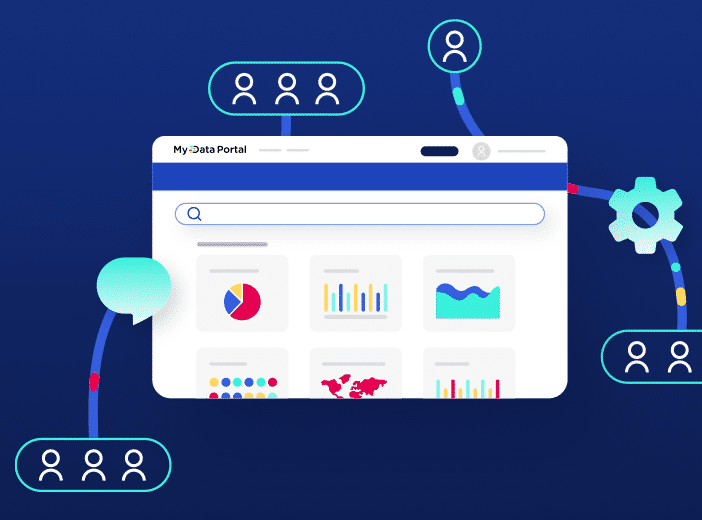2025 data leader trends and the importance of self-service data – insights from Gartner
Growing data volumes, increasing complexity and pressure on budgets - just some of the trends that CDOs need to understand and act on. Based on Gartner research, we analyze CDO challenges and trends and explain how they can deliver greater business value from their initiatives.

As they finalize their plans for 2025, what should Chief Data Officers (CDOs) and Chief Data and Analytics Officers (CDAOs) focus on to deliver results? The recent Gartner IT Symposium/Xpo in Barcelona provided actionable insights around the trends and challenges for the year ahead – and how organizations can successfully respond to them.
Based on key presentations shared at the event, our blog extracts the six key trends involving data and data sharing, helping CDOs to set their strategies and programs for the year ahead, and ensuring that they can demonstrate their key role in achieving business objectives.
The challenges around successful data management
The combination of increasing data volumes and its growing importance to the business provides the opportunity for CDOs to deliver greater value to the organization. However, to guarantee success, they need to understand and overcome five key challenges around data and analytics:
Strategy
Senior management sees the benefits that harnessing data and sharing it across the organization brings. While this is a positive development, it raises expectations – they want CDOs to be supporting data-driven innovation that impacts the bottom line. However, often the complexity of data stacks, the growth in data volumes and increasing demands from the business mean that CDOs have to spend too much of their time on tactical management, rather than supporting innovative new uses for data. These high workloads lead to growing pressure on data teams, leading to a lack of agility and responsiveness and frustration from users.
Financial
The budgets for every part of the organization are being scrutinized closely, and those of CDOs are no exception. Increasing competition and rising salaries for data experts, combined with higher technology costs can all impact the ROI from CDO spending. At the same time overly-complex business intelligence and analytics tools rolled-out across the business lead to waste. Rather than empowering people to self-serve, employees don’t adopt them, leading to expensive projects that deliver little benefit.
Technology
Managers within business units and departments want to access their data and use it on a day-to-day basis. If CDOs are unable to respond to this requirement, it leads to the proliferation of locally sourced and implemented “stealth” solutions, outside the control of the CDO. This adds to security risks and overall complexity, undermining governance efforts, pushing up costs for the business and creating silos of information and tools.
Organizational
As well as an increase in local business intelligence implementations, if CDOs are unable to meet the needs of the business they will lose influence and stature within the organization. Being sidelined risks two things. Firstly, CDOs may face budget cuts or even see their role removed. Alternatively, employees may either use the wrong data for decision-making or make decisions based on gut feel rather than the latest information. In both cases, this undermines trust in data and reduces the use of information.
People
Data skills are increasingly in short supply, particularly with the rise of AI. This is making it harder to source relevant talent, with salaries rising across the board. At the same time growing workloads and greater demand from the business are leading to employee burnout as pressure mounts on existing staff.
Six data trends for 2025
Overcoming these challenges requires CDOs and CDAOs to embrace six trends at both a strategic and tactical level, underpinned by the right technology and processes.
Prove value to the organization
Growing needs from the business for access to data and insights threatens to overwhelm data teams, making it hard for them to respond effectively in a timely manner. CDOs therefore have to take a step back and find ways to deliver tangible benefits to different parts of the business, beginning by listening to their needs and then creating solutions to specific, high-value use cases. Self-service access to data via an internal data marketplace underpins this, providing employees with secure, seamless information in the right format for their needs.
Balance decentralization and control
As mentioned above, there’s a growing risk of stealth or shadow data analytics solutions being adopted by different departments or business units. CDOs clearly need to have control over how data is shared and analyzed, but it is vital that they work with the business, rather than against different departments. They should identify best practices at a local level and roll these out across the organization, training data teams within departments and appointing data stewards and data guardians. This will balance central control with decentralization that allows data sharing to scale and drives engagement, buy-in, and adoption.
Better manage complexity
Data is being created by an increasing number of systems inside and outside the business, meaning that complexity is only going to increase when it comes to data management. This impacts how effectively data is used by employees. For example, Gartner research has found that 47% of digital workers say they struggle to find the information they need to perform their jobs, while 32% admit that they’ve made incorrect decisions due to a lack of awareness that relevant data sources exist. CDOs therefore need to simplify management and governance processes to reduce complexity wherever possible, removing underused tools and focusing on delivering an intuitive user experience that connects employees with all relevant data through solutions such as internal data marketplaces modelled on e-commerce websites.
Build greater trust around data
Even if they can access it, if employees don’t trust the data provided to them, they simply won’t use it. Information therefore has to meet key data quality requirements – it has to be accessible, reliable, understandable and timely, as well as easy to discover if you are to drive reusability. Building trust requires CDOs to collaborate closely with business teams to understand their needs and to focus on quality, starting with the highest value data assets. Data also has to be trusted outside the business, such as by consumers and regulators, with clear explanations of how it has been collected and what it is being used for. Having an audit trail, particularly around customer data, is key for compliance and also for building trust with customers, citizens and wider ecosystems.
Empower employees through self-service data to reduce data team workloads
As increasing data use becomes a key corporate objective, there’s growing pressure on data teams to do more in terms of helping employees and managers across the business to successfully harness information. Rather than adding to workloads by creating and providing more reports to users, CDOs need to focus on building self-service capabilities such as through internal data marketplaces. These enable employees to quickly and confidently find the information they need, without requiring technical support or specialist skills. This has to be underpinned by comprehensive training that encourages and guides everyone to use data in their daily working lives, building confidence and increasing value while reducing the pressure on data teams.
Adopt proactive rather than reactive governance
In many organizations data governance began as part of compliance programs, ensuring that confidential information was protected and that regulatory needs were being met. While risk management is still a critical element of governance, it is vital that it goes beyond compliance to drive business benefits. CDOs and CDAOs understand this – according to Gartner, “By 2027, 40% of CDAOs will have rebranded governance as an enabler of strategic business outcomes.” Achieving this shift requires a combination of security controls (such as identity asset management, single sign-on and row/object level security), and data literacy programs that educate users on how to self-serve data effectively and safely. Combined with an internal data marketplace, this ensures that governance focuses on enablement, adoption and building trust, rather than just reactive compliance.
Understanding the formula for self-service data success
Gartner recommends a four stage process for achieving self-service data success:
- Create trustworthy data
- Secure it
- Train people on how to use it
- Monitor performance and user activities
While this seems simple on paper, delivering it at scale in large organizations with growing data volumes requires strategic direction, strong processes, engagement across the business and the right technology to securely connect users with the data that they need. An internal data marketplace provides the necessary self-service data layer to industrialize data use and monitor activities on an ongoing basis. However, to drive adoption it has to be built around an intuitive experience that makes it simple and seamless for every employee to access data, creating confidence so that they can reuse it without requiring support from data teams. Streamlining administration, such as by automating access controls, further reduces the workload of data teams while meeting user requirements. Overall, it demonstrates the value that the CDO brings, enabling them to focus on more strategic objectives that benefit the business moving forward.
Looking to overcome your data challenges in 2025 and increase data usage? Read our new playbook for CDOs or talk to our experts today.



